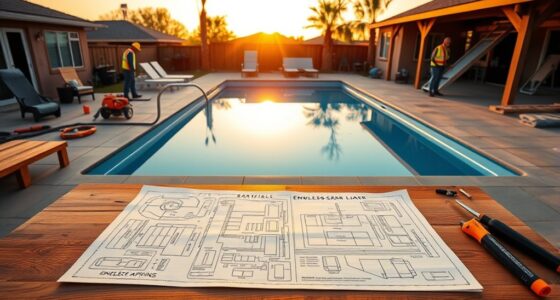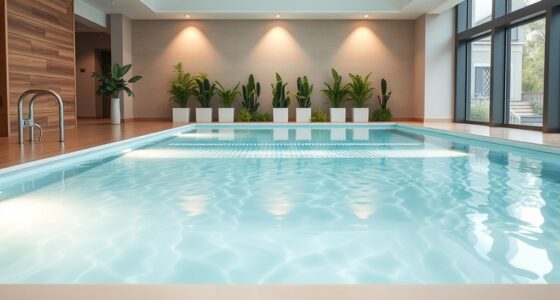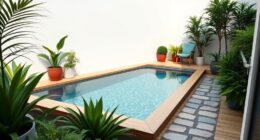Choosing between an endless pool and a lap pool depends on your space, budget, and fitness goals. Endless pools are compact, easy to install, and perfect for versatile, low-impact workouts in smaller areas. Lap pools offer a longer, traditional swim and durable build for serious swimmers but require more space and higher upfront costs. If you want to balance cost and function, knowing more will help you find the best fit.
Key Takeaways
- Endless pools are ideal for limited spaces and versatile workouts, while lap pools suit dedicated swimmers with larger outdoor areas.
- Endless pools typically have lower long-term maintenance costs despite higher initial investment, offering better value for versatile use.
- Lap pools provide extensive customization and durability for long-term use, but require more space, installation time, and higher upfront costs.
- Choose an endless pool for indoor use, small spaces, and multi-purpose fitness, whereas lap pools are better for serious swimmers and outdoor installation.
- Consider safety and mobility needs—endless pools are safer for limited mobility, while lap pools may need additional safety features for accessibility.
Understanding the Design and Functionality of Endless Pools and Lap Pools

Understanding the design and functionality of endless pools and lap pools helps you choose the right option for your needs. Endless pools feature a compact, stationary design with a built-in current generator, allowing you to swim in place. They’re ideal for small spaces and offer adjustable water resistance, making them versatile for different workout intensities. Additionally, endless pools often include scenic views, allowing you to enjoy a more relaxing swimming experience at home. Lap pools are longer, rectangular pools designed specifically for swimming laps. They typically have a straightforward shape with a focus on straight-line swimming, promoting endurance and technique. While endless pools prioritize convenience and space efficiency, lap pools emphasize traditional swimming experiences. Knowing these differences helps you determine whether you want a versatile, space-saving solution or a dedicated swimming lane for more rigorous training.
Comparing Space Requirements and Installation Processes

When comparing endless pools and lap pools, considering their space requirements and installation processes is key to making the right choice. Endless pools are compact, often fitting into small spaces like basements, garages, or patios. They typically arrive as prefabricated units that can be set up relatively quickly, sometimes within a few days. In contrast, lap pools are larger, usually requiring a dedicated outdoor area or a significant indoor space. Installing a lap pool involves excavation, construction, and sometimes extensive landscaping, which can take weeks or months. If your space is limited or you prefer a quick setup, an endless pool suits you better. However, if you have ample outdoor space and want a more traditional pool, a lap pool may be the better fit. Additionally, pool installation processes can vary significantly depending on the type and site conditions.
Evaluating Costs: Initial Investment and Maintenance Expenses
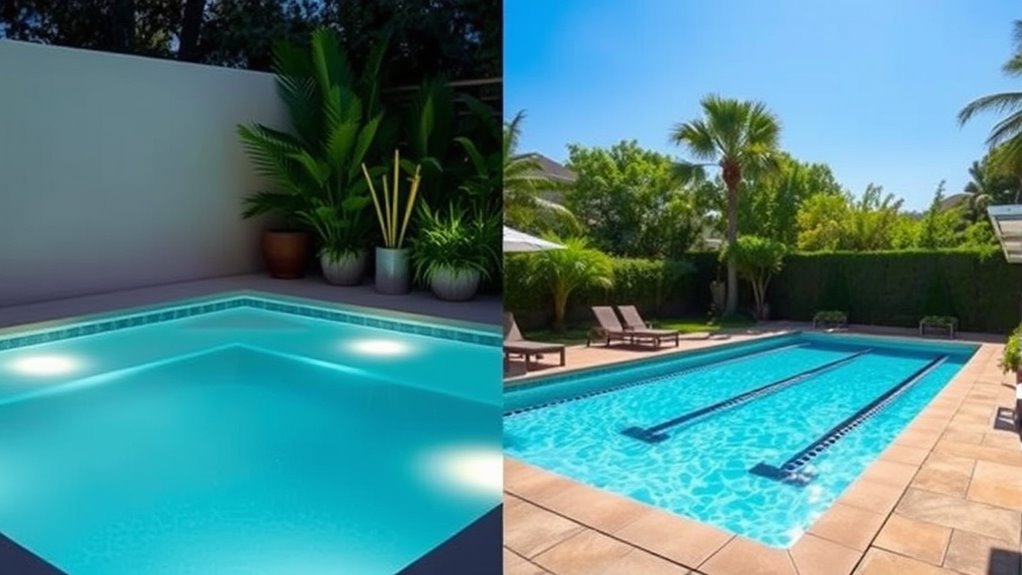
While the initial costs and ongoing expenses vary considerably between endless pools and lap pools, evaluating these financial factors is essential before making your decision. Endless pools typically have higher upfront costs due to integrated systems, but their lower maintenance can save money long-term. Lap pools are generally less expensive initially but may incur higher maintenance expenses, especially if they’re larger or custom-built. Additionally, understanding the cost-effectiveness of each option can help you make a more informed choice.
Assessing Usability and Versatility for Different Lifestyles
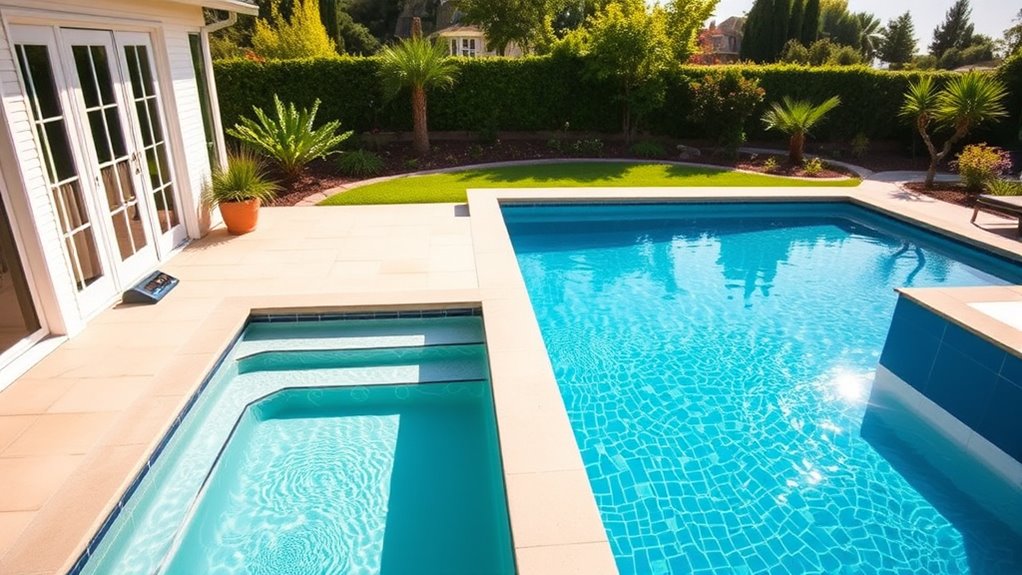
You need a pool that fits your space and lifestyle, so consider how much room you have and how easy it is to install. Think about how versatile the pool is for different exercises and daily use, whether you want casual swimming or dedicated training. Ultimately, choosing between an Endless Pool and a lap pool depends on how well they match your activity needs and available space. Additionally, evaluating the installation requirements can help ensure a smooth setup process aligned with your property.
Space and Installation Needs
Choosing between an endless pool and a lap pool depends heavily on your available space and installation requirements, as well as how versatile you need your pool to be for your lifestyle. Endless pools are compact, making them ideal for small yards or indoor setups, while lap pools require more room for length and width. Installation complexity varies: endless pools often come as plug-and-play units, whereas lap pools may need significant excavation and structural work. Consider the following:
| Feature | Endless Pool | Lap Pool |
|---|---|---|
| Space Requirements | Small footprint, fits indoors/outdoors | Larger area needed, outdoor preferred |
| Installation | Easier, quick setup | Time-consuming, permanent setup |
| Versatility | Multi-functional, fits limited space | Primarily for swimming laps |
| Cost | Generally lower, easier installation | Higher, extensive installation needed |
Additionally, installation flexibility plays a crucial role in determining which option better suits your property and lifestyle.
Exercise Flexibility and Usage
Both endless pools and lap pools offer distinct advantages when it comes to exercise flexibility, but their usability varies depending on your lifestyle and fitness goals. An endless pool provides versatile options like resistance training, water aerobics, and low-impact workouts, making it ideal if you prefer varied routines or rehab exercises. Its compact design allows you to switch between swimming and other aquatic activities easily. A lap pool, on the other hand, is best if your focus is consistent, uninterrupted swimming for endurance or cardio training. It’s less adaptable for different workout styles but excels at long, steady swims. Consider how you plan to exercise—if versatility matters, an endless pool might suit you better. For dedicated swimming, a lap pool offers a straightforward, purpose-built solution.
Analyzing Longevity and Potential for Customization
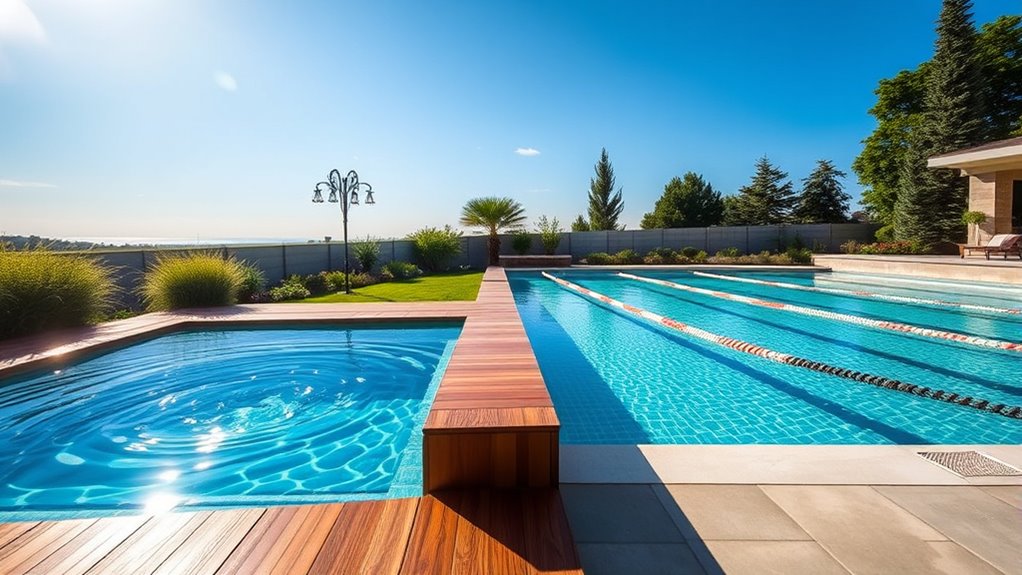
When considering the longevity and customization options of endless pools versus lap pools, it’s important to evaluate how each design holds up over time and how adaptable they are to your specific needs. Endless pools, typically prefabricated and modular, tend to have a shorter lifespan but offer easier updates or upgrades. They often feature flexible configurations, allowing you to add accessories or adjust dimensions within their design limits. Lap pools, especially custom-built ones, usually last longer due to durable materials like concrete or gunite, which can be renovated or expanded later. They also provide more extensive customization options, such as incorporating advanced features or tailored shapes. Your choice depends on whether you prioritize long-term durability or the ability to modify your pool to evolving needs. Cookies and other privacy considerations can also influence your decision-making process by affecting how you manage the technology and features integrated into your pool area.
Considering Safety Features and Accessibility
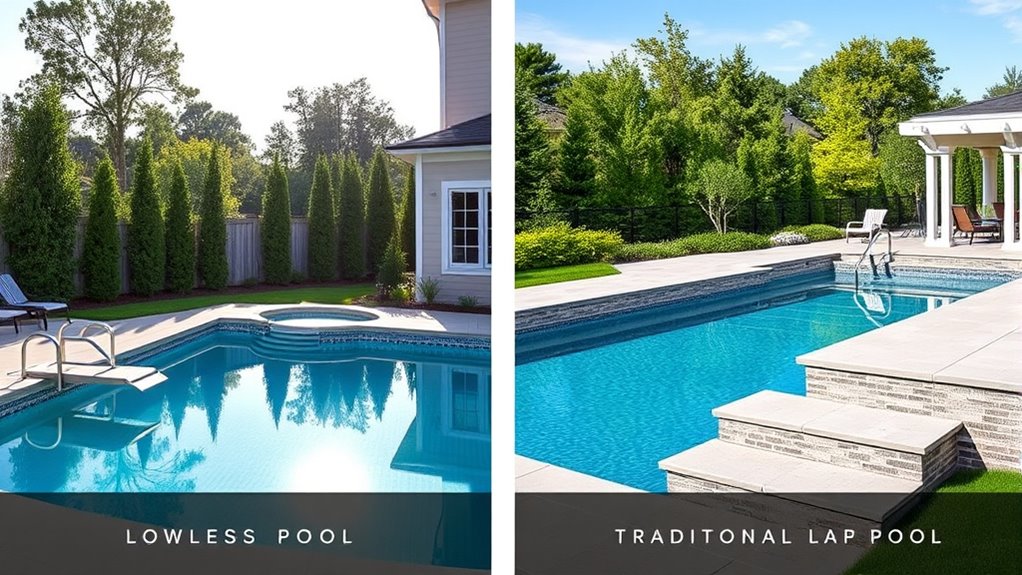
Safety features and accessibility are critical factors to contemplate when selecting between an endless pool and a lap pool. Endless pools often include built-in safety covers, lockable lids, and shallow depths, making them accessible for all users. Lap pools, typically larger and deeper, may require additional safety measures like handrails, non-slip surfaces, and clear depth markers. Accessibility also involves ease of entry and exit; endless pools generally offer step-in designs, while lap pools might need ladders or stairs. Consider this table for clarity:
| Feature | Endless Pool | Lap Pool |
|---|---|---|
| Safety Measures | Safety covers, shallow zones | Handrails, slip-resistant surfaces |
| Accessibility | Step-in entry, compact design | Ladders, stairs, larger space |
Additionally, understanding the pool size can help determine which option is more suitable for your space and lifestyle. Choose based on your safety needs and mobility.
Making the Best Choice for Your Budget and Lifestyle Needs
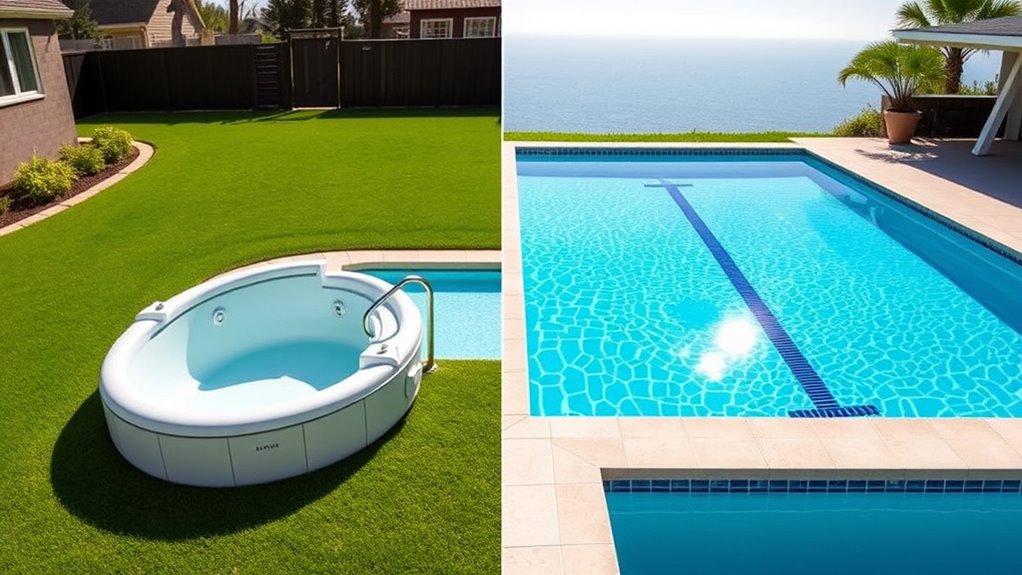
When choosing between an endless pool and a lap pool, your budget and available space play key roles. Consider what fits within your financial limits and how much room you have for installation and use. Making the right choice means balancing costs with your swimming habits and lifestyle needs. Additionally, space‑saving designs can influence your decision by offering efficient options for smaller areas.
Budget-Friendly Options
Choosing a pool that fits your budget doesn’t mean sacrificing quality or enjoyment. To save money, consider these options:
- In-ground pools with basic features are often more affordable than high-end models.
- Above-ground pools offer a budget-friendly alternative, quick to install, and easy to maintain.
- DIY kits can cut costs if you’re comfortable with installation and maintenance.
- Portable or inflatable pools provide seasonal use at a fraction of the cost, perfect for occasional swimmers.
- Opting for pools with easy maintenance features can help reduce long-term upkeep costs and effort.
Space and Usage Needs
Evaluating your space and how you plan to use your pool is essential to making the right choice for your budget and lifestyle. If you have limited space, an Endless Pool is a smart option; it’s compact and can fit indoors or outdoors without taking up much room. It’s ideal for versatile use, from swimming laps to exercising or relaxing. On the other hand, if you have ample outdoor space and want a dedicated lap swimming area, a traditional lap pool might suit you better. Consider how often you’ll use the pool and who will use it. For regular swimmers or families with multiple users, a larger lap pool could be worth the investment. Matching your space and usage needs guarantees you get the most value from your pool. Additionally, space optimization is a key factor to ensure your pool fits seamlessly into your environment and meets your functional needs.
Frequently Asked Questions
Which Pool Type Offers Better Energy Efficiency?
A lap pool generally offers better energy efficiency because it’s larger and uses a traditional pump system, which consumes less energy for maintenance. Endless pools, with their built-in, compact systems, tend to use more energy due to their continuous circulation and heating requirements. If you prioritize saving on energy bills, a lap pool might be the smarter choice, especially if you plan to use it frequently.
Can Both Pools Be Installed Indoors?
Yes, both pools can be installed indoors. You’ll need enough space and proper ventilation for either option. Guarantee your ceiling height accommodates the pool’s dimensions and that your flooring can support the weight. Installing indoors offers protection from weather and maintains a controlled environment, making swimming more convenient year-round. Just plan carefully with a professional to ensure proper setup, ventilation, and drainage for a safe, enjoyable indoor swimming experience.
Are There Size Limitations for Residential Homes?
Yes, there are size limitations for residential homes, but they vary depending on your space and local building codes. You should measure your available area carefully and consult with installation experts to guarantee the pool fits comfortably. Smaller models are designed for limited spaces, while larger pools may require more extensive planning. Always check your home’s structural capacity and zoning regulations before proceeding to avoid any issues.
How Do Maintenance Routines Differ Between Pools?
Maintenance routines differ mainly in scale and complexity. For an endless pool, you’ll typically do weekly checks of filters, clean the cover, and monitor water chemistry, which is quick and straightforward. Lap pools, however, require more frequent skimming, brushing, and chemical balancing due to larger surfaces and volume. You’ll also need to run the pump longer and keep up with more extensive cleaning to make certain water clarity and equipment longevity.
Which Pool Type Adds More Property Value?
A traditional lap pool tends to add more property value because it appeals to a broader range of buyers, especially those interested in fitness and aesthetics. Its larger size and classic design make it a desirable feature for many homeowners. An Endless Pool adds value too, particularly for those prioritizing convenience and versatility, but generally, a lap pool’s size and traditional appeal have a stronger impact on property value.
Conclusion
Ultimately, choosing between an endless pool and a lap pool is like finding the perfect puzzle piece—both can fit your life, but only one will complete your picture. Think about your space, budget, and how you’ll enjoy it. With the right match, you’ll turn your backyard into a personal oasis, where every swim feels like a invigorating escape. Immerse yourself, and make your decision a splash that lasts a lifetime.


